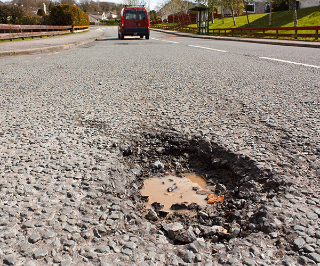
This article is care of https://www.moneysavingexpert.com/travel/pothole-claims/#fullclaim
There are claims it would cost billions to bring the roads up to scratch over the next 10 years, but whoever controls the road has a legal duty to maintain it to a fit standard. If they don’t, and your car’s damaged, they should pay for repairs. That’s the law – our straightforward, step-by-step guide shows you how to use it.
Let us know your tips. The subject of potholes claims is a large and complex one. Please give us your feedback on this guide, suggest improvements and let us know how your claim went in the Pothole claims forum thread.
While every effort’s been made to ensure this article’s accuracy, it doesn’t constitute legal advice. If you act on it, you acknowledge that you do so at your own risk.
In this guide
‘I claimed £498 – a wonderful feeling of winning justice’

Potholes are a plague on Britain’s roads. The Local Government Association claimed in 2016 that it would take 14 years to clear the backlog of potholes, despite councils filling in almost two million per year. The Government has pledged more than £6 billion to try and tackle the problem by 2021.
Whenever we ask you what you’d like us to campaign on, huge swathes of you say ‘potholes, potholes, potholes’. So we wrote this 10,000-word (you don’t need to read it all) guide to help.
If you’ve hit a divot or a crack and your car’s damaged, the process of filing a claim can seem daunting, and many drivers don’t know where to start. But if the authority which was responsible for maintaining the road failed to do so properly, it is possible to successfully claim for repairs in full.
Of course, you can only claim if the authority was at fault. Potholes are inevitable, particularly in winter, so the key question is whether it could and should have fixed it before your car went clunk.
Remember, in reporting a pothole, you’re being a good citizen. And if the authority was negligent and didn’t do the checks it should have, claiming for repairs can help put pressure on the powers that be to keep the road safe and in good condition. Equally though, this is taxpayers’ money and in the short term claims can put local councils under real pressure, so you’ll need to decide for yourself what the right thing to do is.
It can be a long slog, but don’t be put off – we’ve seen many successes:
Two mangled alloys and one tyre, £735 worth of damage. Claim now settled for the full amount after initially being thrown out. Thank you MSE for the pothole claim guidelines.
– Mrchewie
I hit a pothole on the M20 motorway on my journey home from work and suffered a cut to a tyre. I claimed from the Highways Agency and got £530.
– David
I went through the small claims and Bucks County Council threw in the towel 48 hours before the hearing. They paid me everything (£400) and the pothole hadn’t been reported before.
– Richard
Our claim eventually went to the small claims court. It increased to £498 with court fees, interest and compensation. It requires persistence and a lot of time. But it can result in a wonderful feeling of winning justice.
– Tom
Surprise surprise my original claim was rejected by the local authority. Not to be deterred I sought the maintenance history through the FOI route which seemed to infer that problems in the street had not been actioned over the three months prior to my event.
Once I reported the damage and indicated my intention to claim, the repairs were completed the day after. The process has taken nearly three months but my claim will now be paid in full as a goodwill gesture although no liability is being accepted for the damage. I can live with that though! The moral – don’t be deterred.
– Forbecs
The best advice is persevere. The forms sent to me were phrased to make me give up before I started. However I was so angry I completed every step (hurdle) and eventually I was compensated for the replacement wheel and tyre I required.
– Ca55ie
Before you start, keep in mind that it isn’t always easy to claim for pothole damage. While there are successes, there are many instances where claims are rejected too.
Get Our Free Money Tips Email!
Pothole claims – the need-to-knows
Before you get into actually making a claim, here are the big questions answered.
- Your car. You’ll need to show the damage done, so take several clear pictures of anything that’s broken, severed, dented or scratched.
Take notes and gather the paperwork
Any documentary evidence will boost your case, so it’s important to collect as much supporting paperwork together as possible. Here are some of the things to consider (although don’t worry if you don’t have something for every point):
- The pothole’s exact position: Make a note of its location – eg, where it sits in the road, which lane it’s in (if that applies) and how many metres it is from the pavement. Note any landmarks on either side of the road. If there’s a prominent building nearby (say a church or a school), ensure you get its name.
- The accident itself: Keep a record of the moment you hit the pothole. Write down the exact time and date, and try to describe the conditions – the weather, traffic and so on. Be as accurate as you can.
- Did anyone see you hit the pothole? If they did, and if it’s possible to contact them, ask if they’ll put something in writing for you. For example, if it was impossible to see the pothole on approach, or if it was clearly a hazard, ask if they’ll confirm this. This may help your claim further down the line.
- A map-like sketch: If you can, do a quick sketch of the pothole, the stretch of road it’s on and a couple of buildings or signs either side. Don’t worry too much about the quality, it doesn’t have to be Van Gogh.
If possible, try to make any notes as soon as possible after the event, and date them. If the worst comes to the worst and you have to go to court, ‘contemporaneous’ notes (ie, those written at the time something happened) are generally considered more reliable.
Keep a record of the damage to your car
This bit’s crucial. Remember, you’re not claiming for general compensation as such, you’re reclaiming the cost of repairs to your car.
When you get your car looked at and then repaired, keep a copy of your bill and make sure it’s clearly itemised and dated. If possible, ask the mechanic to put it in writing that the damage was caused by a pothole – if you can, it’ll really help later on.
Try a fast claim first
By now you should know which authority’s responsible for the pothole you hit, and you should have reported it (if not, go back and do so now). You should also have gathered a variety of evidence.
Now it’s time to claim. The simplest and fastest way of doing this is by using the authority’s own claims process – normally it just means filling in a form. Not every authority lets you do this, and if they do, it’s not always successful. But it’s always worth trying first.
Forumite reduceditem was successful doing this, posting:
I claimed from Glasgow City Council for pothole damage that required both coil springs to be replaced. They sent me out a form that I completed and returned with photos.
Several weeks later they sent me a letter simply asking me to send them my garage repair bill. Some time after that I got my cheque.
Here’s how to file a fast claim – and remember, if you’re not sure who to claim from and report the pothole to, check here:
- Councils in England, Wales or Scotland. Some councils in England, Wales and Scotland will send you a form to complete when you report a pothole. If not, you can check whether your council allows fast claims by looking on its website. A full list of council websites can be found at Gov.uk. If your council doesn’t have a fast claims system, skip to How to make a full claim.
- Transport for London: You should be sent a form after reporting the pothole – if it doesn’t arrive, call 0343 222 1234. There are separate forms for drivers and cyclists. Once you’ve sent it off, TfL’s insurance provider Gallagher Bassett will investigate your claim. There’s no official timeframe for you to get a response though.
- Highways England: Again, you should be sent a form when reporting the pothole. If not, call 0300 123 5000. The form should arrive in 15 days. After you send it in, the agency has 90 days to respond.
- Major roads in Scotland: All the agencies that look after motorways and A roads in Scotland should send you a form when you report a pothole – if not, call either Bear Scotland on 0800 028 1414, Scotland Transerv on 0800 028 1414 or Amey on 0800 521 660. The form should arrive in two working days. Bear Scotland says responses generally take 28 days – Scotland Transerv give no firm timeframe.
- Traffic Wales: If you asked for a form when reporting the pothole, you should have been sent an information pack and claim form – if you didn’t or it hasn’t arrived, call 0300 123 1213.
- DfI Roads (business unit that manages and maintains Northern Ireland’s transport network): You can download the form directly from the NIdirect website.
- Private roads: Claiming for pothole damage on a private road generally works in a similar way, but it’s a slightly different process.
Submitting a fast claim
The advantage in submitting a fast claim if you can is that it’s just that – fast. The only thing you have to do is fill in the form you were sent by the authority and send it off, along with any evidence they request. However, it’s helpful at this stage to include any additional evidence you have to boost your case.
To strengthen your claim, we’ve also created a short template letter to send alongside the form, which briefly outlines your case and makes it clear that if you don’t receive compensation for the damage to your car, you’re ready to take it further. Although you don’t have to send this, it’ll show the authority you’ve done your homework and are prepared to take it on.
FREE template letter. Download a short letter to make your fast claim faster.
Hurrah – the claim’s submitted
After you’ve sent the form off, it may take a while to hear back. When you do, one of the following three things will happen:
-
You win and get full costs back – victory!
If this happens, congratulations! Your claim’s finished.
-
You get a partial offer.
Be prepared to compromise – it saves time and hassle. If the authority doesn’t offer all the money for the repairs, just a chunk of it, it’s worth understanding that taking this further is going to take time and there’s no guarantee of success.
Is it offering you enough, and is it worth the time and effort of chasing for the full amount? You may want to reply and say: “I think you should give me a little bit more” to see if it’ll give you a better offer. If you’re still not satisfied, move on to How to make a full claim.
-
Your claim is rejected.
There’s a fair chance that your fast claim will be turned down. If so:
Don’t be put off: this is quite common. It’s a lot easier for organisations to reject people now – even those who will succeed at the next stage.
If you’re rejected, the authority may well quote part of Section 58 of the Highways Act in its rejection letter. That says:
“This requires that a court shall have regard to whether the highway authority knew or could reasonably be expected to know, that the condition of the part of the highway to which the action relates was likely to cause danger to users of the highway.”
It may sound convincing, but don’t give up automatically. Even if the authority/agency was unaware of the pothole because it wasn’t reported, you still have a chance. That’s because you may still be able to prove the road wasn’t maintained properly. The next section shows you how to do that.
How to make a full claim
If you weren’t able to make a fast claim – or you did, and it was rejected – the next step is to make a full claim. Be warned though, it’s not a simple process. We’ll take you through it step by step and give you template letters to make it as straightforward as possible.
In a nutshell, you’re going to make a Freedom of Information request to find out if the authority was inspecting and repairing the road as often as it was meant to. If you can prove it wasn’t, you can argue it should pay for your repairs.
Often the authority will pay up if you’ve proved its negligence, but in a few cases you might need to go to the small claims court.
Step 1: Get the road repair policy and inspection history
This is all about digging into the detail to help give your claim a bigger chance of success.
You’re going to use the Freedom of Information (FOI) Act to get information from the authority responsible for maintaining the road the pothole was on. This Act enables you to request data from public sector bodies and they have to give it to you by law.

Don’t worry – it sounds complicated but it’s actually quite simple. Plus, we’ve created a template letter you can use below, so we’ve already done the hard bit for you.
Your FOI request will get two bits of information from the authority:
- Its inspection logs that show how it maintained the road that damaged your vehicle.
- Its policy for inspecting and repairing its roads. (In many cases, this will be the same as a national policy, but sometimes it differs so it’s best to check).
Sometimes the authority may say you don’t need an FOI request to get this info, but it’s easier to do one all the same. Using an FOI request means the authority legally has to respond within 20 working days. The system’s not perfect – sometimes it takes longer anyway – but most people find that using the FOI Act’s the easiest way of making sure your request isn’t lost in the system.
How to make your FOI request
The simplest way of submitting an FOI request is to email the authority – technically, you don’t have to use any special form of words, just say you’re making an FOI request and ask them your questions. To save you the hassle though we’ve put together a template letter for you to send – just fill in your details and send it off.
Warning: While FOI requests are free across most of the UK, it’s worth noting organisations in Scotland can charge a fee of up to 10% if they think it’ll cost them more than £100 to track down the information you need.
If this affects you, they’ll have to tell you what it’ll cost first – then it’s up to you to decide if it’s worth it as there’s no guarantee your claim will be successful. For more details see the Scottish Information Commissioner’s website.
If you do decide to send in an FOI request, use our template below.
FREE template letter. Download our FOI request for councils letter to send off.
Although in theory you can send your request to anyone at the authority and they should pass it on to be dealt with, in practice it’s best to contact the FOI department directly. This should be listed on the authority’s website – if not, call it up and ask.
The authority has 20 working days to respond to your request. Usually, you’ll get a response before the 20 days is up. If you don’t, send a reminder on the 20th day. If they still don’t play ball, complain to the Information Commissioner’s Office.
Be mindful of the impact of FOI requests, which can put real pressure on councils. Only submit one if you couldn’t use a fast claim.

The first thing to check is the inspection logs, which should tell you how often the road you came a cropper on was inspected and repaired. Here are the key things you’re looking for:
How often were inspections done, and how were they done? Don’t just look at the frequency of inspections. Check the following:
- How were they carried out – by foot or in a van?
- If it was in a van, how fast was the van travelling? Was this too fast to see a pothole?
- Was there just one driver or a driver and an inspector?
- Did the road have a history of problems? If so, were inspections done more frequently?
- If the authority also had to do safety patrols, how were these carried out, and how frequent were they?
If the pothole had already been reported, what action was taken?
- How did the authority define the risk created by the pothole? How was it categorised?
- If it was known about, how long did it take to fix the pothole?
- If repairs were made, did it fix the pothole so that it was no longer a hazard?
- If no repairs were made, how long had the authority known about it before you hit it?
Step 3: Check if the authority followed its own policy – and if that policy met national standards
When the authority responds it should send out its road maintenance policy. There are two things you need to check here: first, what its own policy is for inspecting and repairing roads, and second, whether this meets national standards.
The idea here is to see if the authority was negligent. If it didn’t inspect the road your pothole was on as often as it should have, or didn’t repair it as quickly as it should have, you’ve got a decent case. Sit down with the road maintenance policy and inspection logs in front of you and go through them line by line, matching up how they compare.
If you believe you have a case, you’ll need to build an argument. You need to see if there are any discrepancies between the authority’s maintenance policy and what it actually did. The authority may have a justification for some discrepancies, but the more you can find, the better your chance of success. Here are the key things to look out for:
Once you’ve gone through all the small print, make a list of all the discrepancies you’ve found between what the authority was SUPPOSED to do and what it ACTUALLY did. If you’ve found one or more significant discrepancies, your claim’s got a good chance.
Check the authority meets national standards
After looking at whether the authority followed its own road maintenance and inspection policy, there’s one more thing to check: does the policy itself meet national standards?
This only applies to councils, which each operate their own different standards. If you’re claiming from anyone else, skip this step and go straight to Step 4: Submit your claim.
Although individual councils can make up their own set of rules, there is a separate document called the Well-maintained Highways Code of Practice which sets out national standards. Even if the council followed its own rules, there’s a chance its rules weren’t adequate – so you might still be able to argue negligence.
Get Our Free Money Tips Email!
Step 4: Submit your claim
Deep breath; it’s time to up the ante and submit your full claim. Don’t worry, we’ve done a lot of the legwork – our free template letter will help and you can use it as a model for your claim letter.
The letter you send will set out your argument using everything learned so far. Remember, keep calm and try to use neutral language, nothing too emotive. This’ll help if your letter is ever used in court proceedings down the line (let’s hope it never gets that far).
You need to state clearly that you’re owed for the cost of repairs as the authority is liable, and explain why you believe it has been negligent. You’ll then have to argue either that the authority failed to follow its own road maintenance and inspection policy, or that its policy failed to match national standards (or, very occasionally, both).
Whoever you’re claiming from, make sure you closely refer to the evidence throughout your claim. If you think the road wasn’t inspected frequently enough, for example, quote the right bit of the road repair history to prove that’s the case.
Finally, ensure you include all the relevant evidence you’ve collected.
FREE template letter. Download a letter for councils to send off for your full claim.
Step 5: When you’ve submitted your claim, one of three things will happen
First, you’ll usually just get a confirmation of receipt of your claim. You may be passed on to a firm that handles claims for the council, in which case it could be a couple of months before you get a response. If not, it’s usually about a month before you hear back.
Then, one of these three things will happen:
-
You win and get full costs back – victory!
The authority will send a letter and a cheque. Case closed. You’re getting the money back and don’t need to read any more. Well done! Now let us know how you did it in the Pothole Claims forum thread.
-
You get a partial offer. Be prepared to compromise.
The authority might make a partial offer for the repair costs. If this happens, be willing to compromise – it’ll save time and hassle. Taking it to court from here can be an expensive process and you’re not guaranteed to win.
-
Your claim is rejected.
Despite all your hard work, there’s still a chance the authority may flat out reject your claim. Sometimes, they’ll send a detailed explanation of why they won’t make an offer. It might look like the Magna Carta – in one case a council sent a 200-page refusal letter to a driver who’d claimed for £40.
Still unsatisfied? Try small claims court

If you go through the whole process and they still reject your claim, your options are unfortunately limited (unless you’re making a claim in Northern Ireland). You do have the right to take your claim to the small claims court (or sheriff’s court in Scotland) though.
Don’t think automatically of judges and wigs – the small claims court is the low-hassle way to take legal action for up to £10,000 (£5,000 in Scotland) against a firm or individual. But you need to be confident you’ve got a case before you start, as there are fees if you lose.
You can see full info for small claims in England, Wales and Scotland in our Small Claims Court guide.
If your claim is in Northern Ireland, you CAN pursue it further with the Department of Infrastructure (DfI).
If you still believe there are discrepancies between what the DfI should have done and what it did in terms of maintaining the road you encountered a pothole on, you can write back to them, explain these discrepancies and state that you’re making an official complaint.
If you’re unsatisfied about the general way your claim was handled, you can also complain to the DfI Roads Claims Unit. This is more about delays and communication though, rather than the decision itself.
If you exhaust the complaints process and there’s still no satisfactory resolution, then unlike in the rest of the UK, there is somewhere else to turn.
You can take your case further by contacting the free NI Ombudsman. It will provide you with an independent adjudication – if this goes against you, then it’s highly likely any court action will be unsuccessful.







